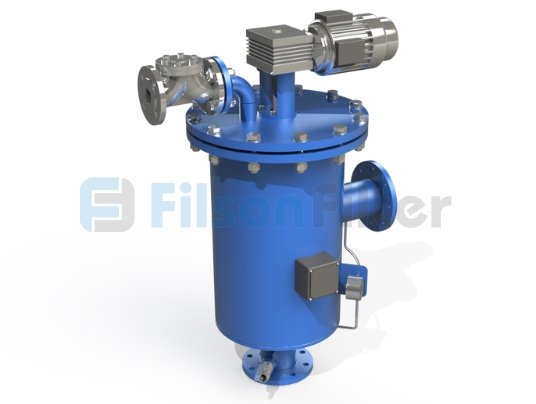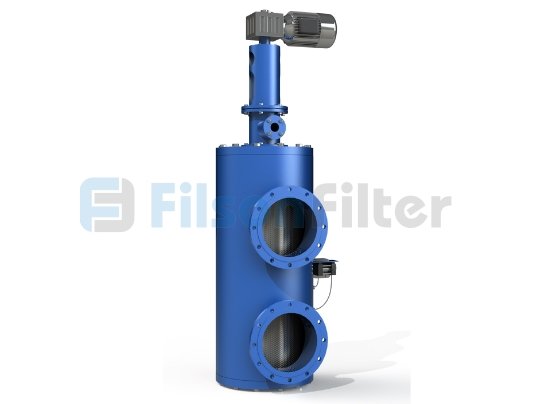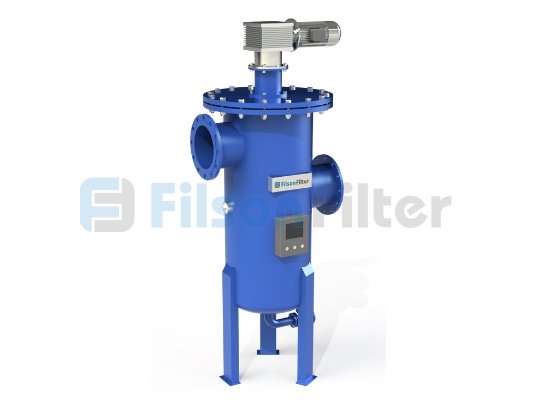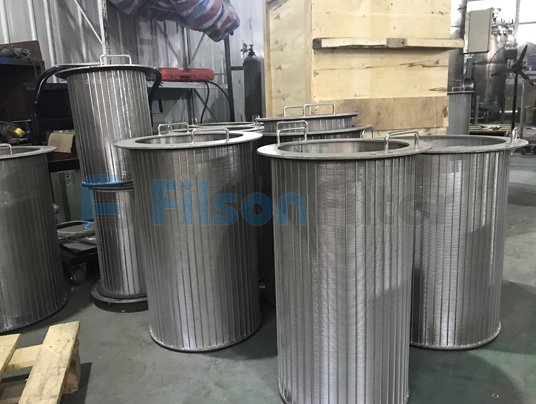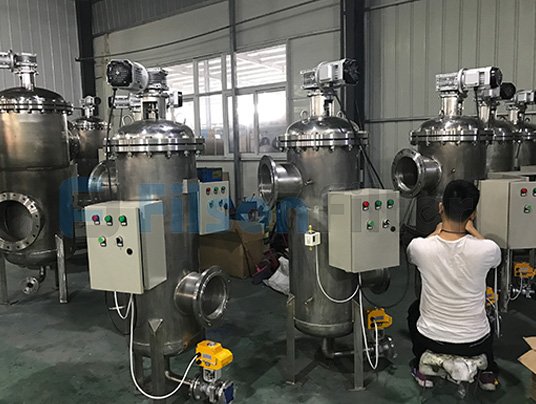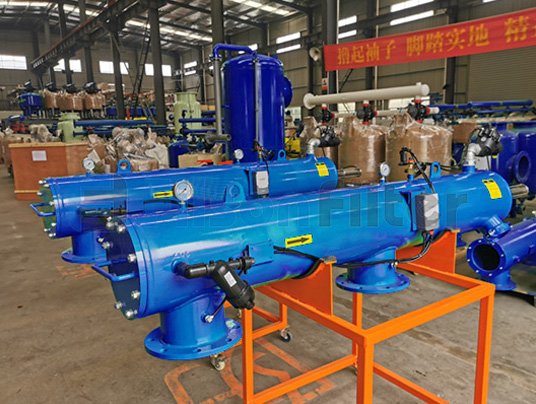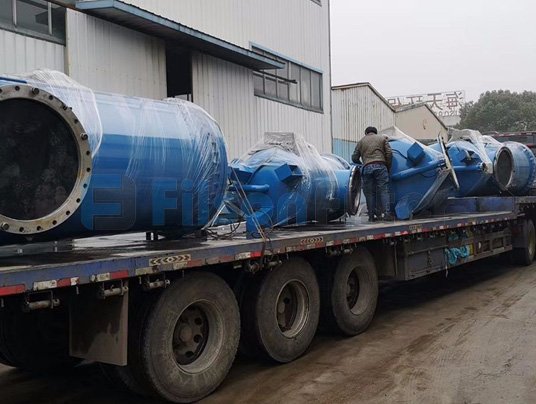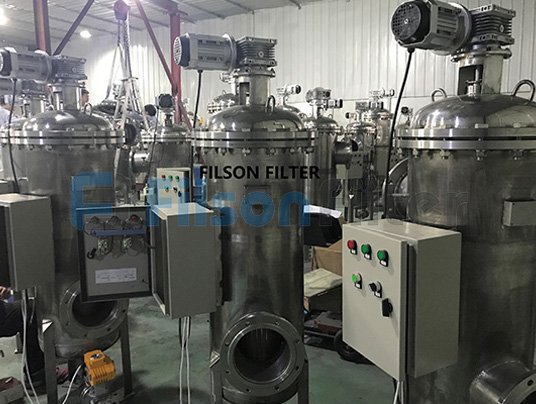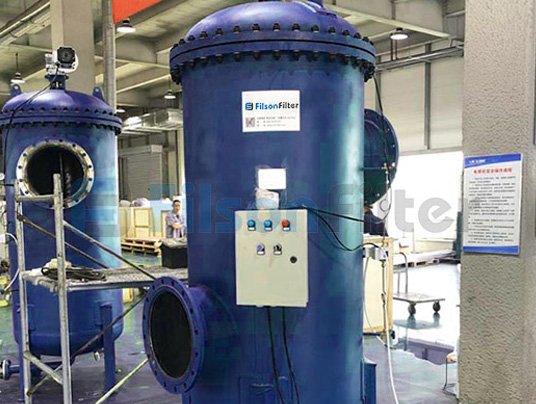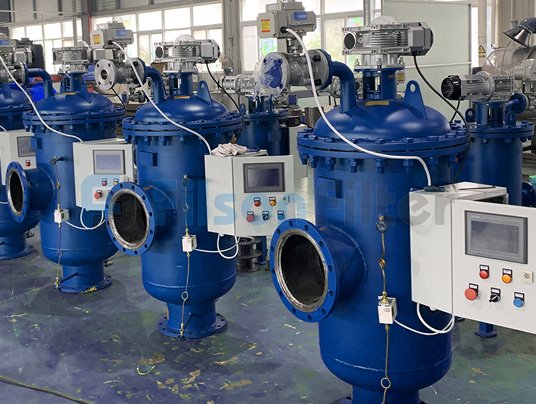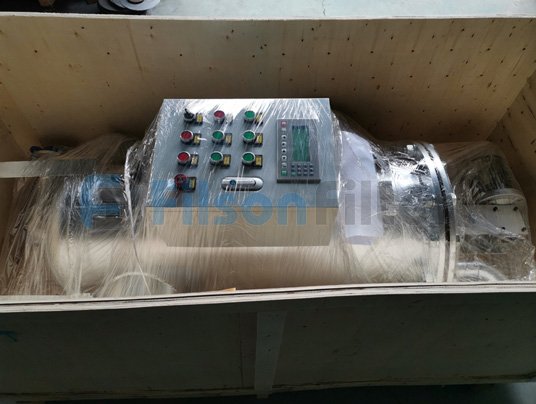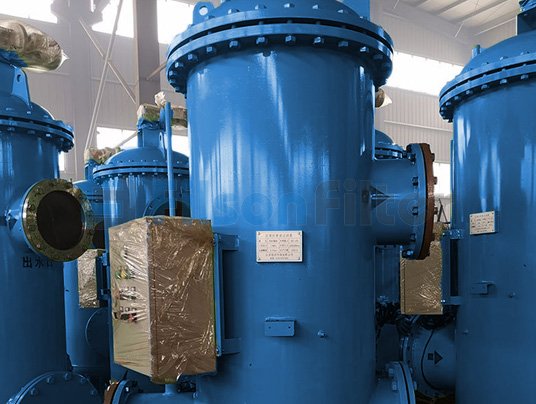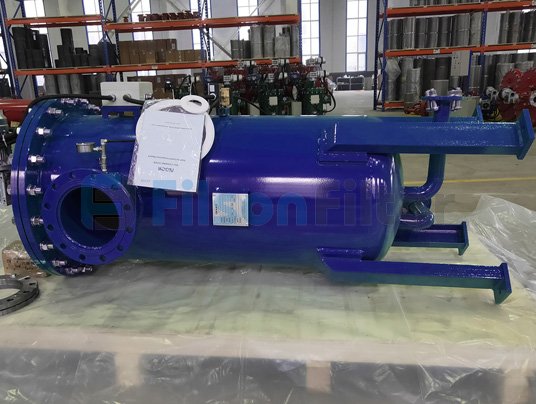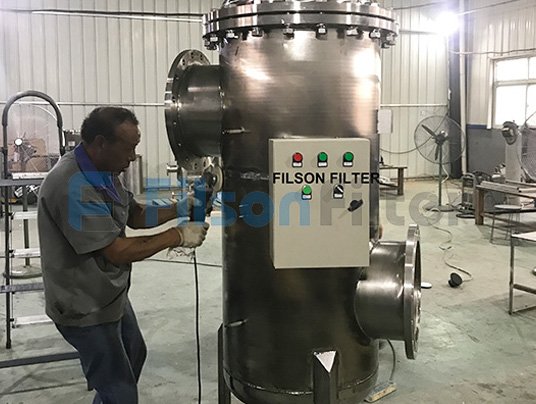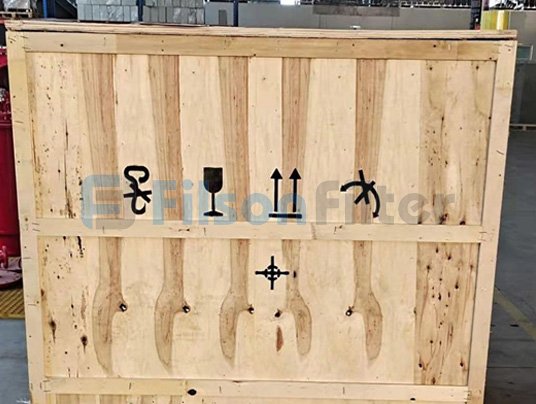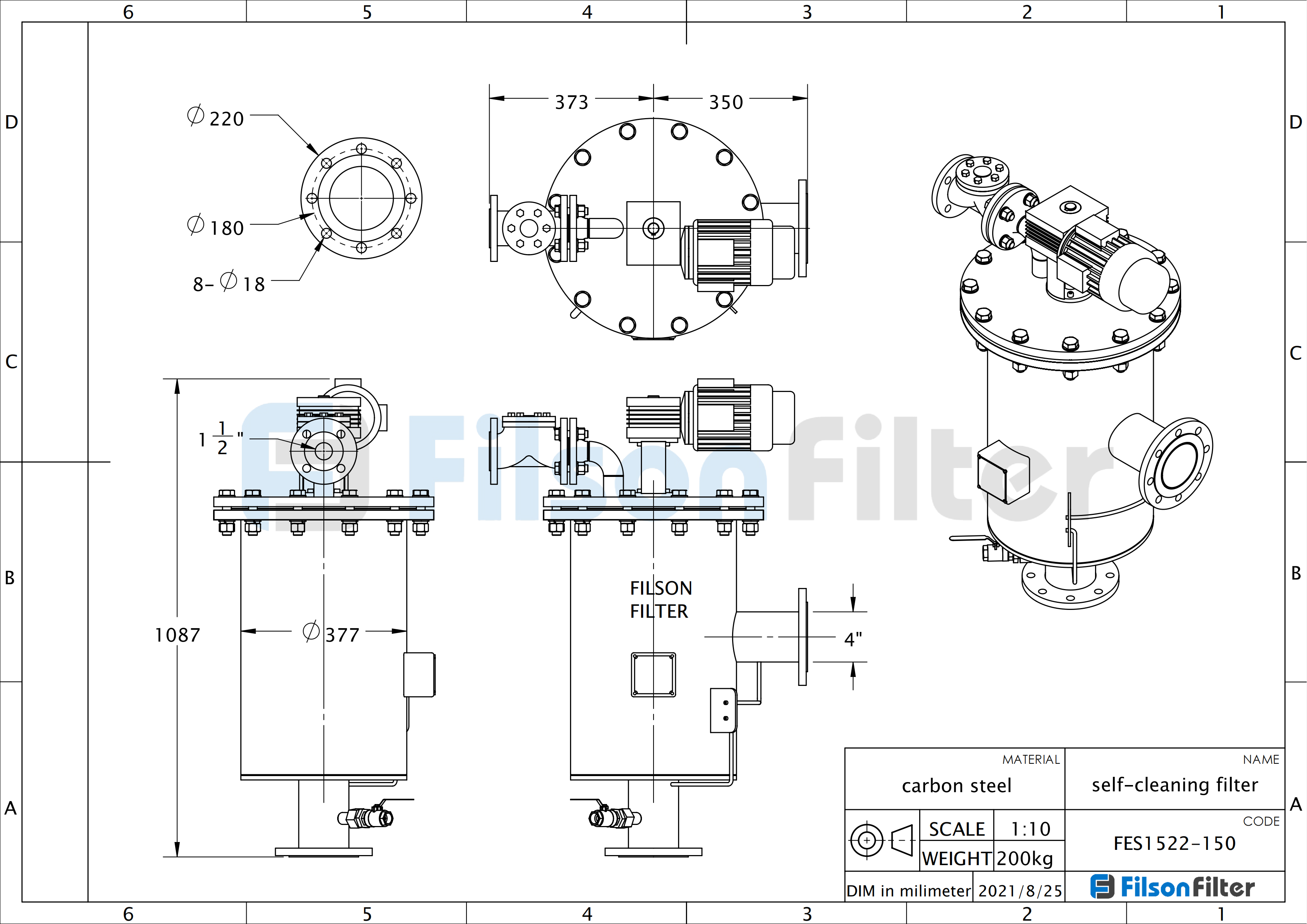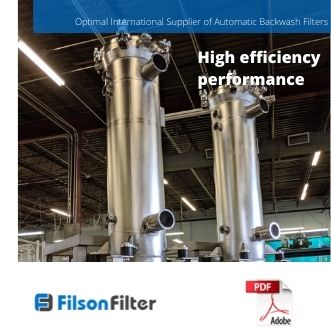Your Optimal International Supplier of Automatic Backwash Filters
Filson automatic backwash filters represent the perfect option for water treatment, pulp & paper industry, steel making, power plant, and provide the most productive and labor-free solution. Especially for the liquid with high content of suspended solids or high viscous slurry, it can perform effectively.
Filson auto backwash filter overcomes plenty of disadvantages in conventional manual filters, providing large dirty holding capacity, easy cleaning, and can precisely monitor the filtration phase. It has an intellectualized system to supply accurate cleaning intervals while ensuring uninterrupted liquid flow during the whole back washing process.
Automatic Backwash Filter
Why Choose Filson Automatic Backwash Filter?
Superior Quality: We ensure to produce an automatic filter with the highest raw material and precision design
Fast Response: We guarantee that your inquiry and messages will be replied to within 8 working hours
Strict Check: We provide a series of strict quality tests on each Filson automatic filter before packing
Quick Delivery: We promise that your will receive your automatic filters within 14 working days after payment
OEM Service: We always offer to customize services for worldwide customers to meet special filtration challenges
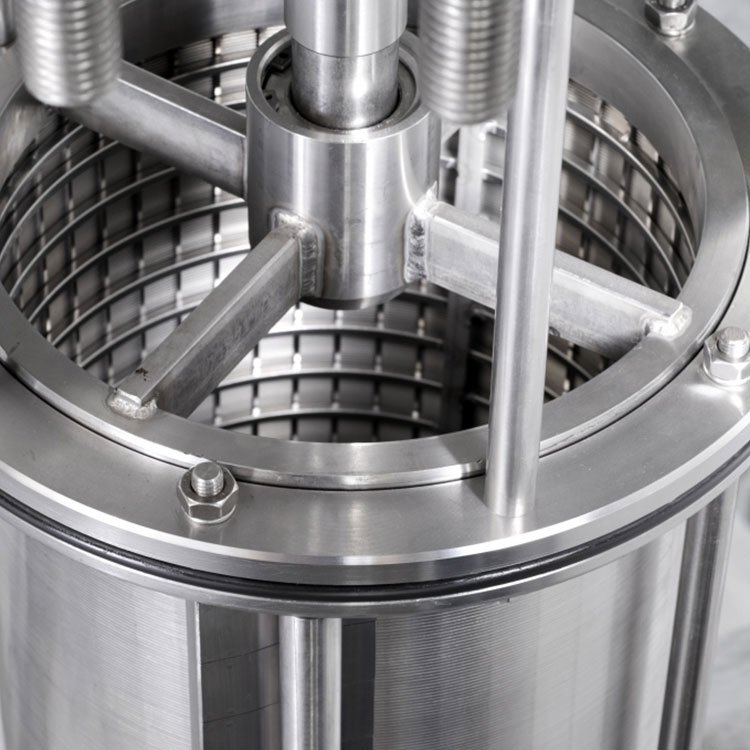
Filson: One Stop Solution For Automatic Backwash Filter
Filson automatic backwash filter, also referred to automatic filter, automatic strainer, automatic self cleaning strainer, auto self cleaning strainer, auto backwash filter, automatic backwash strainer, auto backwash strainer. It is an ideal solution for the filtration system requiring continuous production process.
Filson automatic filters are mainly made of carbon steel, stainless steel, super duplex or other alloys upon your unique request. And its insert filter element can be manufactured by wedged wire screen, woven wire mesh, sintered mesh screen or perforated plate.
The backwash ability of Filson automatic strainer is realized through the pressure drop change between outside and inside. It offers a continuous self cleaning cycle to efficiently remove unwanted debris and particles, while maintaining the filter operation normally.
Automatic strainers from Filson are widely recognized for their design flexibility, they are typically designed to remove contaminant ranging from 30 to 3200 micron. Furthermore, both horizontal and vertical installation two options are applicable to fit your installation space.
Compared with conventional manual filters, Filson automatic backwash filter is a type of intelligently controlled filter with higher operational security and cost performance. It can be controlled more precisely of contaminant removal cycle according actual need.
Filson automatic self cleaning strainer is available in the flange connection size from 1.5” to 40”, with a wide range flow rate up to 4000m3/h. Moreover, it can filter normally at the operating pressure up to 2.5Mpa, or other unmentioned specifications are always can be customized upon your requirements.
All Filson automatic filters are constructed for durability and longevity. It provides regular back wash cycle to help you prevent adhesion of retained debris to filter surfaces. Therefore, it can ensure long service internals and drastically save costs of manual cleaning.
Filson has been manufacturing automatic backwash filters for over 18 years. With rich fabricating and design experience, our expert engineer team is capable of assisting you to complete your business successfully by a series of advanced production&test equipment.
In addition, we have a variety types of auto backwash filter models to support your diverse applications, certainly model customization is always allowed if our existing model can not meet your needs. So do not hesitate to send us your specific data or drawings.
Before delivery, a team of Filson quality inspectors will test your automatic filters strictly. Besides, we will package with special plastic bubble inside and customized wooden case outside, to guarantee safety of your auto backwash filters.
If you are unsure what you need, reach out to one of our specialized engineer to learn more!
Or, are you searching for other type filters? Filson can also supply: sintered metal filter, wire mesh filter, basket filter, hydraulic filter element, coalescing filter element, wedge wire filter …
Would like to contact us?
Phone call: +86 157 3695 8886
Email: sales@filsonfilters.com
Filson is always here to help you solve your filtration problems!
Filson Auto Backwash Filter Working Principle
Filson auto backwash filter is a precision filtration equipment to purify liquid and protect another device of the filtration system. Fluid enters the Filson auto backwash filter body through the water inlet. Then the unwanted contaminants are retained here and cleaned fluid discharges through the outlet.
Filson auto backwash filter has an intelligent design that can achieve the automatic identity of the impurity deposition degree. When the differential pressure reaches a pre-set value, the controller will transmit a signal to trigger the backwashing process. During the backwashing process, the filtered fluid will flow back, and the dirt particles of the screen surface will be flushed off. Or you can specially set up a pump as an external connection, utilizing extra pressure to backflush the filter screen.
Filson Automatic Filter Benefits
- The unique self-cleaning design provides long service life
- Regular backwash cycle with uninterrupted filtration
- No manual supervision to reduce the labor costs
- Multiple installation types for limited installation space
- The large surface area with high dirt holding capacity
- Minimal liquid loss during the backwashing process
Filson Automatic Filter Specifications
- Material: CS, SS 304/316L, 2205, nickel alloy
- Connection type: flange
- Flange connection size: 1.5-40 inch
- Filtration accuracy: 30-3200 micron
- Operating pressure: 10-25 bar
- Flow rate: up to 4000m3/h
- Installation direction: vertical or horizontal
- Filter element type: wedge wire screen, woven wire mesh, sintered mesh, perforated plate
Filson Automatic Filter Applications
- Water treatment
- Pulp & paper
- Sewage treatment
- Snow production
- Irrigation system
- Power plant
- Mining industry
- Marine industry
People Also Ask
This is a type of filter that consists of mechanisms of cleaning itself once clogging occurs on the filter.
It uses the filtration fluid to clean itself in a process that removes all the contaminants from the filter.
These contaminants are low out of the system via the discharge valve. You can then continue with the filtration process.

Backwash Filter System
The working of a backwashing filter is relatively simple as long as you understand the functionality of its various components.
The control valve is the one responsible for initiating the backwashing process of your filter.
The backwashing filter involves the reverse flow of the fluid that is flowing from the exit point to the entry point.
The flow of the fluid raises the floor bed of your filter due to its pressure, thereby cleaning it.
The floor bed usually contains a filter medium, which is generally a granular substance.
You can have a different filter medium depending on the type of your backwash filter.
The common filter medium available includes carbon, sand, zeolite, garnet, granular manganese dioxide, anthracite, and greensand.
Under regular operation, the filter bed is responsible for holding and trapping al contaminants as the fluid flows.
The flow of the fluid is generally from top to bottom or from outside to the inside.
As this happens, there is the creation of channels on the bed of the filter. This is because fluid tends the following path with less resistance.
Channeling has the effect of reducing the effective filtration process of your fluid.
Once the backwashing process is complete, the fluid flows through the control valve into the drainpipe of the filter.
This process takes a couple of minutes before the normal filtration process continues.
The control valve is responsible for initiating this process.
Yes. Backwashing filters are the same as self-cleaning filters.
They are a type of self-cleaning filter since they can clean themselves during the filtration process.
They do this by using the same fluid that they are filtering.
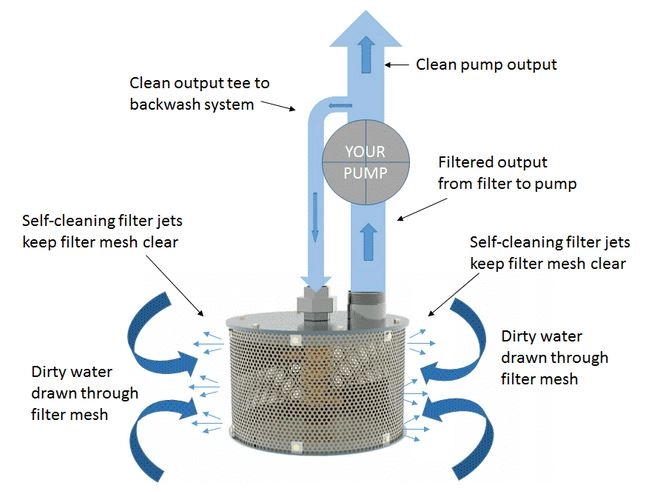
Self Cleaning Filter
Backwash filters offer several benefits both to your fluid as well as the operation of your equipment.
Such benefits include:
- Minimizes on Costs
The use of backwash filters helps in reducing the cost of having to replace worn-out and inefficient filters.
This is through cleaning the available filters ready for the filtration process.
- Efficient filtration
The filtration process removes all the contaminants present in a fluid.
Filters hold these contaminants during the filtration process resulting in their clogging, which hinders efficient filtration.
However, the backwash filter clears the clogging process offering an efficient filtration process for your application.
- Equipment durability
Clogging affects the quality of your filtration process.
The inadequate filtered fluid causes your equipment or machinery not to function appropriately.
However, the backwash clears the clogging, which ensures you have clean fluid for the proper functioning of your machinery.
- Saves time
Backwash filters tend to take less time filtering your fluid as compared to conventional filters.
This is because of the backwashing mechanism, which ensures the cleaning of the filters when there is clogging.
Less time filtering your fluid implies high production for your equipment.
It depends on the kind of backwashing filter that you select.
There are two types of backwashing filters available for your selection, that is, automatic and manual backwashing filter systems.
The manual backwashing filter system involves manual controlling of the backwashing process.
Under this type, you have to check the contamination level of the backwash filter physically.
In an Automatic backwashing filter system, all the operations are computer-controlled. This saves time and is efficient.
Once clogging occurs on the backwash filter, the system automatically shuts the filtration process and immediately initiates the backwashing process.
Like any other type of filtration system, you will experience several limitations when using a backwash filter system.
Such limitations include:
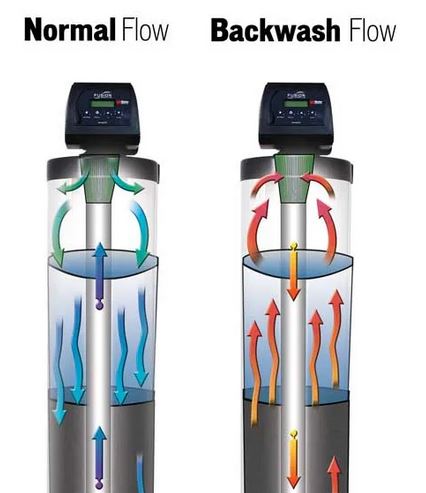
Backwashing Filter
- Cost
The cost of purchasing a backwash filter is relatively expensive when you compare it to the other types of filters.
You, therefore, have to budget for both the purchasing and maintenance of the backwash filter system.
- regular maintenance
To enhance its performance, you have to maintain your backwash filter regularly. This can be time-consuming and tiresome.
Backwashing plays a critical role in the proper filtering of your fluid.
First, backwashing ensures you have clean filters for your operation.
This offers you quality filtration of your fluid.
Through proper filtration, you have durable filters, as well as your equipment.
Once there is proper filtration due to a quality filter, there is an efficient operation of your application.
The duration of backwashing filters depends on several factors.
First, is the pressure of the fluid, which affects the cleaning procedure.
The size of the backwash filter will determine how long it takes.
In general, the larger the backwash filter, the more time it takes.
The size and type of contaminants also determine the time it takes for cleaning your backwash filters.
Denser and oily contaminants take more time during the backwashing process.
The standard PSI of a backwash filter system should be more than the operating pressure of your backwash filter.
This will efficiently remove all the contaminants from the backwash filter.
The use of a backwash filter is vital in various applications.
There common application areas for backwash filters are:
- Pharmaceutical industry
- Food industry
- Locomotive industry
- Manufacturing industry
The main difference is in its operation.
The manual backwash filter utilizes a manual setup for cleaning itself during the backwashing process.
An automatic backwash is a computer-controlled type of backwash filter.
In this type, you set the operations in a computer, and the backwash filter picks the commands and executes them.
A backwashing filter plays a critical role in the filtration of your fluid by holding contaminants as it flows.
Its ability to clean itself during the filtration process helps in reducing the operational cost.
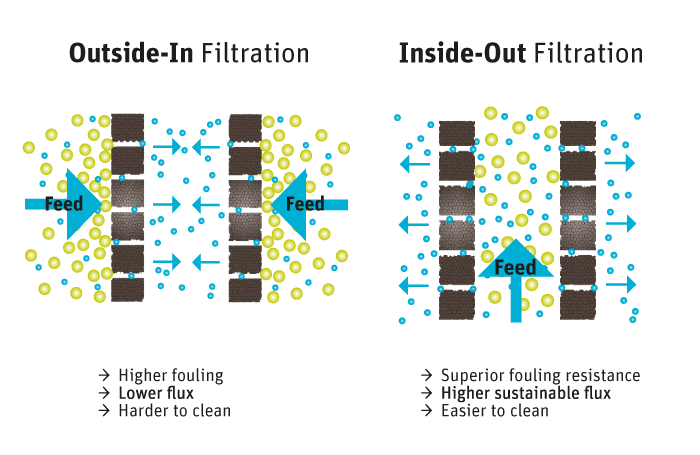
Outside in Vs. Inside Out Filtration
The main difference between these two is in the flow direction.
In an outside-inside flow, the fluid flows into the backwash filter.
In an inside-outside flow, the fluid flows from the backwash filter to the outside.
Inside-outside flow is common during the backwashing process.
The outside-inside flow is vital during the filtration process of the fluid.
The pressure of the inside-outside flow is relatively lower than that of the outside-inside flow.
This is because the entry point of the inside-outside flow is smaller.
An outside-inside flow has a large diameter of the entry point and a smaller diameter of the exit point.
Optimum backwashing rate is ideal in offering quality filtration for your fluid.
A low backwashing rate causes poor filtration of your fluid.
A high backwashing rate can lead to the busting of the filtration medium.
Among the factors that affect the rate of backwashing in your filter system includes:
· Operating Temperature and Pressure of your Fluid
If you have a high operating temperature, the backwashing rate will reduce.
This is because of the effect it has on the backwash filter system.
Low operating temperature also affects the backwash rate since the fluid flow will reduce.
Low pressure reduces the flow of the liquid, which affects the backwashing rate.
You must ensure that both the temperature and pressure are at an optimum rate for effectively handling the backwash rate.
· The Size of your Backwash Filter
A large backwash filter has a lower backwashing rate when compared to a small backwash filter.
The capacity of the backwash filter affects the backwashing rate if all the other factors are constant.
· The Type of Filtration Media
There are different types of filtration media, which affect the backwashing rate.
The pleated backwash filter has a low filtration rate due to the number of pleats available.
A carbon backwash filter or gravel backwash filter has a high filtration rate due to its size and nature.
· Type of Fluid and Contaminants
A fluid with a low viscosity has a high backwash rate when you compare it with one that has a high viscosity.
This is due to the fluid flow, which is faster under pressure than the one with a high viscosity.
If the sizes of your contaminants are dense and have irregular, they will reduce the backwashing rate.
This is because one has o apply more pressure to remove the contaminants.
For continuous and quality filtration processes, there is a need for frequent filter replacement of your backwash filters.
Among the factors that should make you change your backwash filters include:
- Tattered filter element
If your backwash filter has a tattered filter element, then you need to replace it.
The tattered filter element results in poor filtration of your fluid.
This is because contaminants can flow through the filter into your equipment.
- Poor filtered fluid
When your activated charcoal cannot hold any more contaminants, you have to replace it.
This is due to the saturation of the charcoal by the chemicals present in your fluid.
You will notice a color change on the activated charcoal and a gain in weight when it has reached the saturation point.
- Crushed cartridge
if the inner part of your cartridge is plastic, the chances are that it may collapse due to weight over it.
If it happens, the entire cartridge collapses, which affects the filtration process.
When such occurs, then you need to replace your backwash filter
- High-pressure readings
If you notice pressure readings that are above the normal recordings, then you have to replace your backwash filter.
The main cause of this has a dirty cartridge.
If you try cleaning the cartridge, but there is no change, then you have to replace it with a new one.
- Old backwash filter
If your backwash filter works for a given time without replacement, then you need to replace it.
This way, you have a guarantee of the quality of your filtration process.
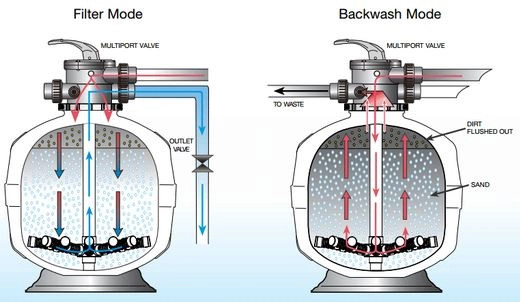
Filter and Backwash Filter Mode
A backwashing filter has a mechanism of cleaning itself when clogging happens.
A typical filter depends on the manual cleaning of the filter element during clogging.
Using a backwash filter results in high production since there is little disturbance during the filtration process compared to regular filters.
The core function of both backwash and ordinary filters is to remove contaminants from fluids.
A backwashing filter has a wide range of applications when compared to a normal filter.
A filtering media is that part of your backwash filter that holds contaminants from flowing through your application during operation.
Different filtering media are depending on the type of backwash filter.
The primary filtering media are:
- Carbon
Carbon, in this case, activated charcoal is the most preferred option for backwash filters.
This is because they are relatively cheaper and have a wide range of uses.
Activated charcoal is effective in removing chemicals from different fluids.
However, it requires frequent replacement, which in the long run, is quite costly.
- Cartridge
There are different cartridge materials available for use on your backwash filter.
These include plastics, pleats, sheets of metals, and carbon papers.
There are two main types of backwash filters, that is, automatic and manual backwash filters.
An automatic backwashing filter is a pre-programmed filter that cleans itself after a selected schedule.
It is an efficient and faster way of filtering your fluid. However, it is costly, which means you have to budget appropriately both for purchasing and maintenance.
A manual backwash filter is one that requires manual scheduling of the backwashing process.
The advantage of this is that it is relatively cheaper than an automatic backwash filter.
However, it is slow and requires frequent maintenance, which affects the filtration process.
Other types of backwashing filters depend on the filter media available in them. These types include;
· Carbon Backwash Filter
The primary filtering media in this type is carbon.
Carbon is the preferred option due to its physical characteristics. Such include;
A carbon backwash filter is an ideal option for filtering water, air, and industrial gas.
Among the contaminants it removes include siloxanes and chlorine and hydrogen.
It is relatively cheaper and highly effective.
However, it has a low service life, which requires constant replacements.
This is quite costly.
· Cartridge Backwash Filters
This type uses a cartridge as the main filter medium.
They are ideal in the removal of contaminants such as solid particles and even chemicals from fluids.
You can have different materials for the cartridge backwash filter.
They include wound strands of materials like polypropylene.
They are relatively expensive when compare to carbon backwash filters.
The carbon backwash filter uses activated charcoal for filtration.
Cartridge backwash filters consist of different wounded materials such as polypropylene.
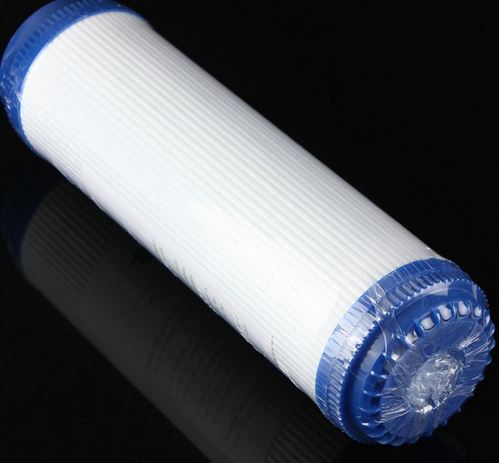
Activated Carbon Filter
Cartridge backwash filters are relatively expensive when compare to carbon backwash filters.
Carbon backwash filters are ideal for filtering contaminants that are chemicals such as siloxanes, chlorine, and hydrogen.
Cartridge backwash filters effectively filter contaminants such as solid particles and certain chemicals.
Carbone backwash filters are durable when compare to carbon backwash filters.
Carbon backwash filters require constant replacement for them to function appropriately.
This is costly in the long run.
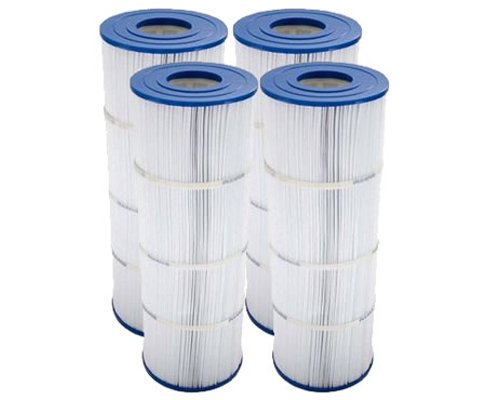
Cartridge Filter
With the availability of different backwash filters in the market, it becomes a challenge to select an appropriate one for your application.
However, paying consideration to critical factors will help you in deciding the right one for your application.
They include:
- Purpose
Different backwash filters serve different filtration functions. This brings out different filtration quality standards.
Also, the availability of different filtering fluids affects the type of backwash filter that you select.
When selecting a backwash filter for your application, you have to check on the purpose you want it to serve.
- Filtration fluid
different filtration fluids have different characteristics that affect the filtration function.
Such features include fluid viscosity, operating temperature, and pressure.
The backwash filter you select should not react with fluid and should ensure there is a proper filtration process.
- Filtration media
There are different filtration media for use, depending on which fluid and the type of filtration you want.
The typical filtration media are carbon, sand, zeolite, garnet, granular manganese dioxide, anthracite, and greensand.
Each of these media has its unique ability to hold contaminants of different sizes.
- Filter mesh size
The backwash filter mesh size is the size of the individual pores of the filter.
These sizes affect the quality of filtration since it holds particles that are higher than the given size.
Depending on the quality of filtration, you may have to select a backwash filter with the correct filter mesh size.
- Backwashing rate
The backwashing rate has the effect of determining the duration of filtration and the speed of operating your application.
A higher backwashing rate implies that it takes less time for the backwashing process to take place and the overall filtration process.
This means your equipment operates at a higher speed.
- Type of backwash filter
There are generally two types of backwashing filters, automatic and manual.
The choice depends on how you want your equipment to run and the available resources.
Disinfecting backwash filters is vital for the overall quality of the filtration fluid.
This is critical, especially in human-sensitive products such as milk and juice.
You must use a disinfectant that is non-reactive to the filter and also to the fluid that you are filtering.
After disinfecting your backwash filter, you should let your backwash filter dry at a high temperature before using it.
You can achieve this through the use of the sun or machines to sterilize it.
Yes. You can quickly get a customized backwash filter.
However, you need to submit the specification of the backwash filter to your manufacturer in advance.
A reliable manufacturer will streamline these specifications to ensure they meet the necessary standards before manufacturing.
An effective backwash filter should offer the necessary performance as per the expectation of the user.
The common parameters that you can check on the quality of your backwash filter include:
- Size of the contaminants
Choosing the correct size of basket filter that corresponds with the contaminant sizes facilitates its performance.
The backwash filter holds all the contaminants of that particular size, thereby facilitating the filtration process.
- Type of fluid
Different fluids have different characteristics, such as viscosity and reaction to the backwash filter.
An adverse reaction implies that over time, there is a compromise on the performance of the backwash filter.
Low viscosity tends to slow down the filtration process hence lowering the performance of the backwash filter.
- Operating temperature and pressure
A high fluid operating temperature causes wear and tear to the backwash filter, especially if it does not have the corresponding temperature limits.
For the adequate performance of your backwash filter, it has to have a higher operating temperature as compared to that of the operating fluid.
The operating pressure results in the bursting of the backwash filter, especially if it does not have high strength.
This compromises the performance of your filter.
It is, therefore, vital for the backwash filter to have a high operating temperature and pressure than that of the filtering fluid.
- Filter mesh size
The filter mesh size should be less than the size of contaminants that you want to filter from the fluid.
A higher filter mesh size than that of the contaminants implies contaminants will flow through the filter into your application.
This results in the low performance of your backwash filter. What are the Quality Standards for Backwash Filter?
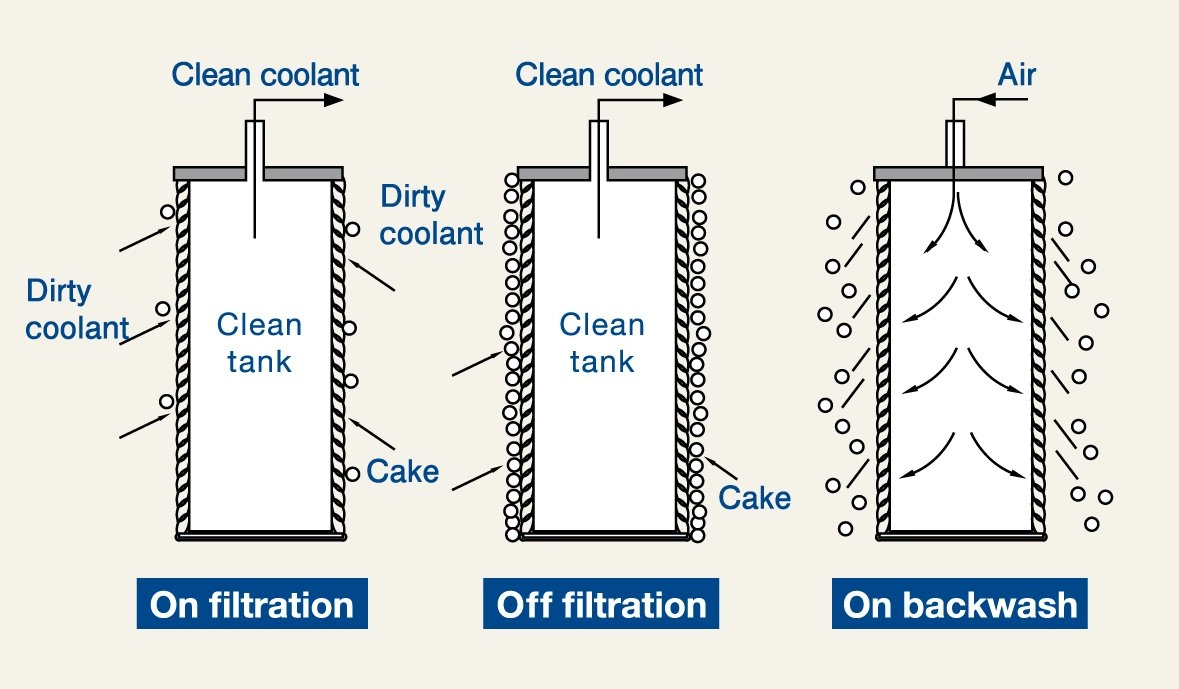
3 Modes of Filtration
Proper backwash filter manufacturing should adhere to given standards before they are out in the market.
The main quality standards that a given backwash filter should certify are:
- Burst resistance standards
- End load standards
- Flow fatigue characteristics.
- Bubble point standards
- Fluid compatibility standards
- Flow characteristic standards
- Filtration performance standards
Clearly, backwash filters play an integral role in modern filtration systems.
However, analyzing and evaluating every aspect covered in this guide is quite critical.
At times, the information available out there can be so overwhelming. That’s why FilSon team is here to help – contact us now.
